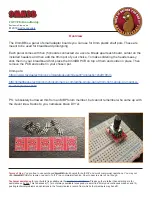
Convenient functions during mixdown/bounce operations
9
Mixdo
wn and bounce oper
ations
95
AW1600 Owner’s Manual
The chapters entitled “Track recording” and “Overdub-
bing” explained how to load an EQ library and use the
Selected Channel section [EQ] knob to make adjustments.
Here’s how you can make more detailed adjustments to
the EQ parameters.
1
Press an [INPUT SEL] key, a pad 1–4, a
[TRACK SEL] key, or the [STEREO SEL] key
to select the channel whose EQ you want to
adjust.
2
If desired, load library data from the EQ
library.
3
Repeatedly press the Selected Channel
section [EQ] knob or hold down the [EQ]
knob and use the CURSOR [
]/[
] keys to
access the EDIT page of the EQ screen.
The EDIT page of the EQ screen lets you edit all of
the EQ parameters.
1
ON/OFF button
Switches the EQ on/off.
B
Response curve
Graphically indicates the approximate response of the
EQ.
C
FLAT button
Move the cursor to this button and press the [ENTER]
key to reset the boost/cut amount of all bands to 0 dB.
D
ATT. (Attenuation) knob
Attenuates the signal immediately before it is input to
the EQ, over a range of –96 to 0 dB. This is used
mainly to prevent the signal from clipping when you
use the EQ to boost a specific frequency region.
E
Output meter
Indicates the level of the signal after it has passed
through the EQ.
F
Q knobs
Specify the Q (steepness) at which each band (HIGH,
HI-MID, LO-MID, LOW) will be boosted or cut. The
range is 10–0.10, and higher settings will produce a
steeper curve.
G
F (Frequency) knobs
Specify the center frequency of the boost/cut, over a
range of 21.2 Hz–20.0 kHz.
H
G (Gain) knobs
Specify the amount of boost/cut, over a range of –18.0
dB to +18.0 dB.
4
Move the cursor to the parameter that you
want to edit, and use the [DATA/JOG] dial to
adjust the value.
5
To switch the LOW band type, move the cur-
sor to the LOW band Q knob and turn the
[DATA/JOG] dial toward the left.
With the default EQ settings, the LOW band is a shelv-
ing type. (The value field for the Q knob will indicate
“L.SHL”.)
If you turn the Q knob toward the left, the Q knob
value field will change to a numerical value, and will
switch to the same boost/cut type as the HI-MID and
LO-MID bands.
If you continue turning the Q knob toward the left, the
Q knob value field will indicate “HPF,” and the LOW
band will function as a high-pass filter. If “HPF” is
selected, you can use the LOW band G knob to switch
the high-pass filter on/off.
6
To switch the HIGH band type, turn the
HIGH band Q knob all the way to the left.
With the default EQ settings, the HIGH band is a
shelving type. (The value field for the Q knob will
indicate “H.SHL”.)
If you turn the Q knob toward the left, the Q knob
value field will change to a numerical value, and will
switch to the same boost/cut type as the HI-MID and
LO-MID bands.
If you continue turning the Q knob toward the left, the
Q knob value field will indicate “LPF,” and the HIGH
band will function as a low-pass filter. If “LPF” is
selected, you can use the HIGH band G knob to switch
the low-pass filter on/off.
7
To switch the EQ on/off, press the [ENTER]
key.
In the EDIT page, you can press the [ENTER] key to
switch the EQ on/off (except when the cursor is
located at the FLAT button).
Editing the EQ parameters
8
1
2
4
5
3
6
7
• If the meter display clips because you boosted a certain band,
lower the ATT. knob to attenuate the signal.
• The [EQ] knob of the Selected Channel section will still oper-
ate even while the EDIT page of the EQ screen is displayed.
HINT
Summary of Contents for AW 1600
Page 1: ...Owner s Manual EN ...
Page 12: ...AW1600 Owner s Manual 1 Before you start 12 ...
Page 38: ...AW1600 Owner s Manual 38 4 Recording to a sound clip ...
Page 54: ...AW1600 Owner s Manual 54 5 Track recording ...
Page 228: ...AW1600 Owner s Manual 228 MEMO ...
Page 229: ...229 AW1600 Owner s Manual MEMO ...
Page 230: ...AW1600 Owner s Manual 230 MEMO ...
















































